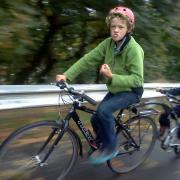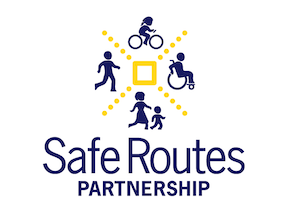 New Jersey’s Zealous Nuts: The 2012 ProWalkProBike: Pro Place conference brought together hundreds of “zealous nuts” who are dedicated to people walking and bicycling more often. Fred Kent, founder of Project for Public Spaces, opened t
New Jersey’s Zealous Nuts: The 2012 ProWalkProBike: Pro Place conference brought together hundreds of “zealous nuts” who are dedicated to people walking and bicycling more often. Fred Kent, founder of Project for Public Spaces, opened t
Resource Library
This webinar provides an overview of technical assistance, resources and funding for Safe Routes to School provided by the Safe Routes Partnership.
 There is a scene, from a once famous movie where this guy busts through the door to expel his undying affection for a woman. She completes him, and he wants to make sure she knows it.
There is a scene, from a once famous movie where this guy busts through the door to expel his undying affection for a woman. She completes him, and he wants to make sure she knows it.
I’m no Tom Cruise, but I want you to know: You complete me.
 The Safe Routes to School Mississippi network prides itself on the ability to connect with those organizations within the state that are passionate about ridding the state of the childhood obesity epidemic. We continue our efforts in expanding our parameters to partners that are champions for the cause. While attending a meeting with the Obesity Coalition (formulated by The P
The Safe Routes to School Mississippi network prides itself on the ability to connect with those organizations within the state that are passionate about ridding the state of the childhood obesity epidemic. We continue our efforts in expanding our parameters to partners that are champions for the cause. While attending a meeting with the Obesity Coalition (formulated by The P

 We travel just over two miles to school each day with our two boys - by bike, of course, most days. I am proud that my ten-year old son is now riding his six-year old brother to school on a tag-along! Both boys insist on it now. This picture shows the Big Guy showing off his tough guy face on a recent school trip.
We travel just over two miles to school each day with our two boys - by bike, of course, most days. I am proud that my ten-year old son is now riding his six-year old brother to school on a tag-along! Both boys insist on it now. This picture shows the Big Guy showing off his tough guy face on a recent school trip.
 The past several months have been rife with debates, campaign speeches and rallies supporting certain candidates, ideologies and policies. Over the past couple of weeks, many Americans have exercised their right to vote into office the state and local leaders of their choice as well as the President of the United States of America.
The past several months have been rife with debates, campaign speeches and rallies supporting certain candidates, ideologies and policies. Over the past couple of weeks, many Americans have exercised their right to vote into office the state and local leaders of their choice as well as the President of the United States of America.
To date, Georgia Safe Routes to School has awarded 48 projects (totaling approximately $18.5 million). Some examples of the various types of infrastructure projects are installation of sidewalks, multi-use paths, crosswalks, raised crosswalks, multi-use paths, LED crossing signs, ADA ramps, bike lanes and bike racks.
This report highlights factors across states that are critical to campaigns for transportation funding and provides examples of successful strategies and tactics.
 Right now my work in the Bay Area region is at a very exciting phase. While earlier in the year our efforts were concentrated on our metropolitan planning organization (MPO)—the Metropolitan Transportation Commission (MTC)—our work now needs to focus on the nine counties of the San Francisco Bay Area.
Right now my work in the Bay Area region is at a very exciting phase. While earlier in the year our efforts were concentrated on our metropolitan planning organization (MPO)—the Metropolitan Transportation Commission (MTC)—our work now needs to focus on the nine counties of the San Francisco Bay Area.
La Lista de control de posibilidades para caminar adjunta es una herramienta que se puede utilizar para mejorar la seguridad del recorrido de nuestros hijos hacia la escuela.
 What better way to ring in the 2013 New Year than to reflect on what we are thankful for and resolve to improve.
What better way to ring in the 2013 New Year than to reflect on what we are thankful for and resolve to improve.
This report provides insight into how Transportation Enhancement and Transportation Alternative funds are being used at the national and state levels. The report is a tool for agency staff, policymakers, professionals, and citizens who want to understand how federal fund- ing shapes America’s transportation system and its communities.
 As we continue to hear more about the intersection of transportation and health issues nationally, Tennessee is making a concerted effort to cultivate this important partnership. Recently, I had the opportunity to witness and participate in this collaboration.
As we continue to hear more about the intersection of transportation and health issues nationally, Tennessee is making a concerted effort to cultivate this important partnership. Recently, I had the opportunity to witness and participate in this collaboration.
The Safe Routes Partnership has released a new national report showing how SRTS programs can be harnessed to keep children safe from traffic dangers while walking and bicycling to school.
The Nevada statewide Safe Routes to School program is in its third round of national Safe Routes to School (SRTS) funding. Funding started in 2008 and the third round of SAFETEA-LU money is funded in 2012 and 2013. The state program covers the major urban areas in the state along with rural areas with a mixture of infrastructure and non-infrastructure projects. Approximately $10 million dollars has been spent or committed so far. There have been 25 projects with 12 partners in the state.
This toolkit provides materials that state advocacy organizations can use to ensure state
Departments of Transportation (DOTs) take full advantage of the potential bicycling and
walking funding in MAP-21.
 Every year since 2005, the public health community has celebrated the first week of April as National Public Health Week, led by our long-standing partner affiliate, the American Public Health Association. And this year, on
Every year since 2005, the public health community has celebrated the first week of April as National Public Health Week, led by our long-standing partner affiliate, the American Public Health Association. And this year, on
This handbook provides strategies to help governing boards create positive school environments where students feel safe,supported, connected to others and prepared to learn.
 The other day I was talking to another parent who is getting ready to move from our Virginia community—which is still very much car-dependent--to a small, bicycle-friendly town in the Midwest.
The other day I was talking to another parent who is getting ready to move from our Virginia community—which is still very much car-dependent--to a small, bicycle-friendly town in the Midwest.

